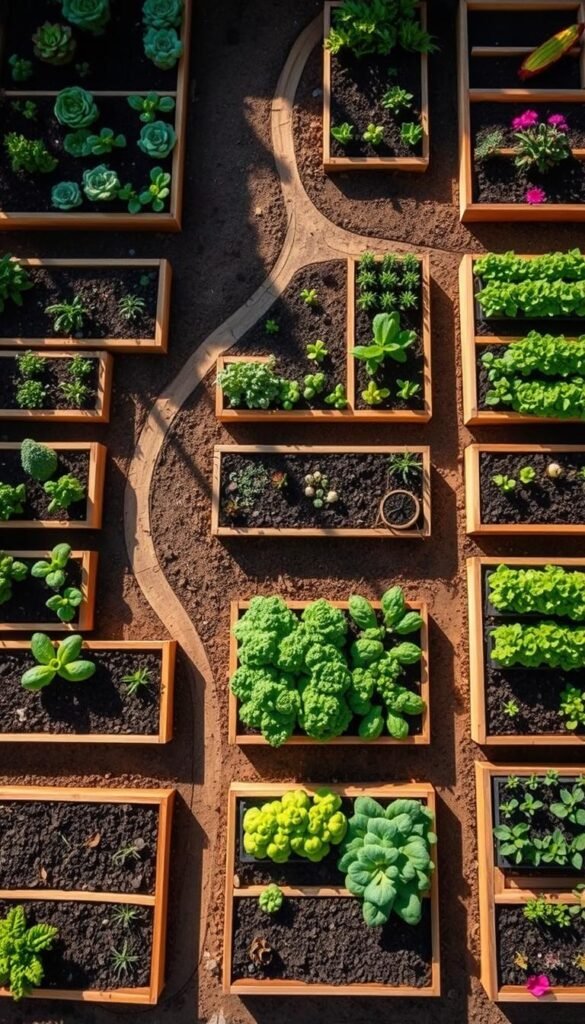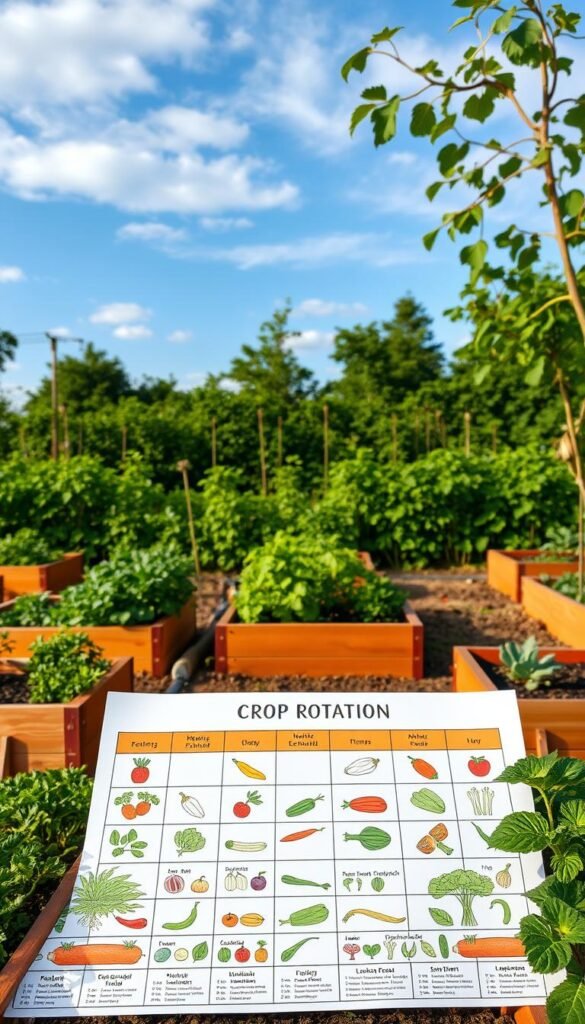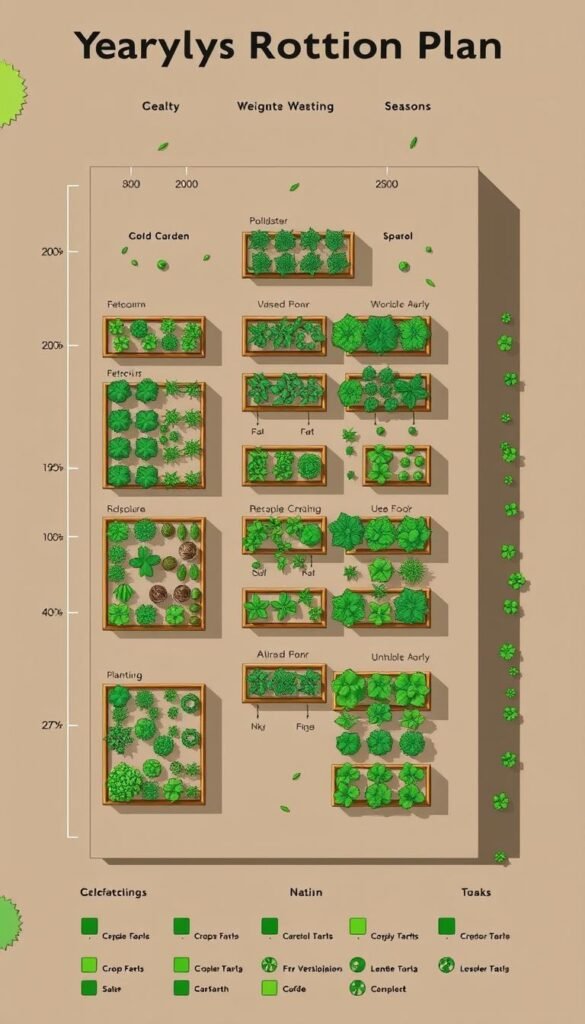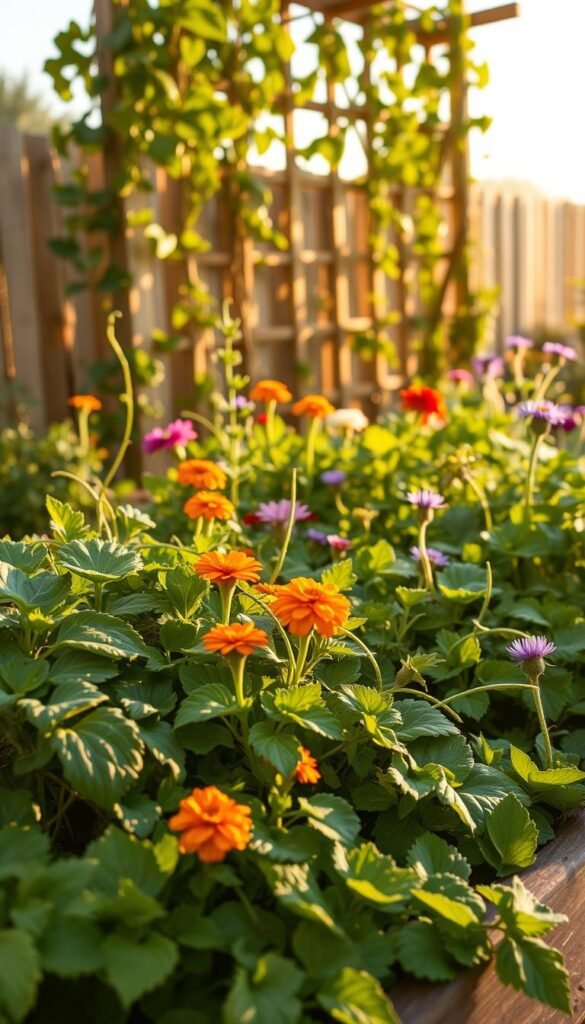Ever wondered how to get healthier plants and bigger harvests from your compact growing area? Changing what you plant each season isn’t just for farmers—it’s a secret weapon for backyard growers. In elevated planting spaces, this method becomes even more powerful thanks to better soil control and drainage.
You’ll find that switching plant families annually stops nutrients from disappearing. It also confuses bugs that target specific vegetables. Unlike traditional plots, contained beds let you manage soil quality precisely—no heavy equipment needed.
We’ll show you how simple patterns create natural pest barriers while keeping your dirt fertile. Discover why leafy greens thrive where root veggies grew last year. Learn to group plants by their needs, making fertilizer work smarter.
Best part? You don’t need more space. With smart planning, every square foot becomes more productive. We’ve broken down proven methods into easy steps—whether you’re growing tomatoes or kale. By the end, you’ll have multiple strategies to match your goals, from battling mildew to boosting yields.
Understanding Crop Rotation Benefits in Raised Bed Gardens

Healthy soil acts like a savings account for your plants. When you rotate crops strategically, you’re making deposits and withdrawals that keep your garden thriving. This approach works especially well in contained growing spaces where soil nutrients stay concentrated.
Balancing Nature’s Buffet
Different plant families use resources uniquely. Tomatoes and peppers (nightshades) guzzle nitrogen, while peas and beans (legumes) actually add it back through root nodules. By switching plant groups each season, you prevent nutrient robbery and maintain soil health.
| Plant Family | Nutrient Impact | Common Examples |
|---|---|---|
| Legumes | Adds nitrogen | Beans, peas |
| Brassicas | Needs high nitrogen | Kale, broccoli |
| Alliums | Low nutrient demand | Onions, garlic |
Outsmarting Unwanted Visitors
Pests and diseases memorize where their favorite meals grow. Tomato hornworms return to last year’s nightshade patch, only to find garlic instead. This confusion tactic works better than sprays – no-dig methods enhance this natural defense by keeping soil ecosystems intact.
Soil-borne illnesses like fusarium wilt fade when their host plants move locations. You’ll notice fewer sick plants and more robust growth as your rotation plan matures. Healthy soil truly becomes your garden’s best insurance policy.
Practical Steps for Setting Up Your Rotation Plan

Ready to turn your growing area into a productivity powerhouse? Start by dividing your space into four equal sections. This simple approach helps manage plant families while keeping soil nutrients balanced.
Mapping Out Your Garden Layout
Grab graph paper or use a square foot garden plan template. Number each section and note sunlight patterns. Color-coding works wonders—assign specific hues to plant groups for quick visual reference.
Identifying Plant Families and Their Needs
Tomatoes share family ties with peppers and potatoes (nightshades), though they look nothing alike. Learn these connections to avoid repeating soil demands. Check our quick-reference table:
| Family | Key Members | Soil Needs |
|---|---|---|
| Legumes | Beans, peas | Add nitrogen |
| Brassicas | Kale, broccoli | High nitrogen |
| Cucurbits | Squash, melons | Rich compost |
Leave space for vining plants in their own zone. Track planting spots yearly using dated maps. This prevents soil fatigue and keeps pests guessing. Your planning today means healthier harvests tomorrow!
Maximizing Crop Rotation in Vegetable Garden Raised Beds

Crafting a smart planting timeline transforms your growing space into a self-renewing system. The magic happens when you stick to a 3-4 year cycle—this breaks pest lifecycles and lets soil recover fully. Think of it like changing seats at dinner: everyone gets fair access to nutrients.
Mastering the Four-Year Cycle
Divide your bed into four zones. Each section hosts different plant families annually. Tomatoes might thrive in Zone 1 this year, then move to Zone 3 in 2025. This simple shuffle stops diseases like blight from settling in.
Try this easy tracking method:
| Year | Plant Family | Examples |
|---|---|---|
| 1 | Legumes | Beans, peas |
| 2 | Brassicas | Kale, broccoli |
| 3 | Alliums | Onions, garlic |
| 4 | Cucurbits | Squash, melons |
Jot notes in a garden journal or use phone reminders. Color-coded maps work wonders—blue for nitrogen-fixers, green for heavy feeders. Pair this with seasonal care strategies for year-round soil health.
Got multiple beds? Rotate families between them. Love growing peppers? Dedicate one bed to nightshades but shift their exact spots yearly. This balances passion with practicality.
Succession planting fits perfectly here. After harvesting early spinach, slot in quick-growing radishes—just ensure they’re from different families. Your soil stays active without risking nutrient depletion.
Designing a Yearly Rotation Plan for Optimal Yield

Imagine your garden as a living calendar where each season writes a new chapter in soil health. A three-year rotation system acts like nature’s reset button, balancing nutrient demands while keeping pests off-balance. This method works beautifully in contained spaces where every planting decision counts double.
Utilizing a Three-Year Vegetable Family Approach
Year One starts strong with nitrogen-loving stars. Tomatoes, peppers, and cucumbers thrive in beds freshly enriched with compost. These heavy feeders build your garden’s foundation, using nutrients to fuel lush growth and abundant harvests.
When Year Two arrives, switch to repair mode. Plant peas and beans—legumes that work like underground fertilizer factories. Their root nodules convert air nitrogen into plant food, naturally replenishing what last year’s vegetables consumed.
| Year | Plant Type | Examples | Soil Action |
|---|---|---|---|
| 1 | Heavy Feeders | Tomatoes, Corn | Use Nutrients |
| 2 | Nitrogen Fixers | Beans, Peas | Restore Balance |
| 3 | Light Feeders | Carrots, Potatoes | Maintain Health |
Year Three brings root vegetables into the spotlight. Carrots and potatoes excel in the balanced soil created by previous plantings. Their modest needs let the earth recharge before the cycle begins anew.
Adapting to Seasonal Changes in Your Garden
Spring’s lettuce makes way for summer beans, then fall garlic—all while keeping plant families rotating. Track planting dates using colored stakes or garden apps. This prevents accidental repeats that invite pests.
Short on space? Try rotating crops in tight spaces by alternating container placements. Even shifting plants 3 feet left each year disrupts insect lifecycles effectively.
Remember: heavy feeders like broccoli need extra compost after legumes. Light feeders such as onions thrive in simpler soil. Match each season’s crops to your rotation phase, and watch your garden become more productive yearly.
Incorporating Companion Planting and Sustainable Techniques

Did you know your plants can team up like superheroes? Strategic partnerships between vegetables, herbs, and flowers create natural defenses while boosting growth. This approach works perfectly with your existing soil management strategy, creating a self-sustaining ecosystem.
Pairing Crops for Mutual Benefits
Tomatoes and basil make garden powerhouses. The aromatic herb repels hornworms while enhancing tomato flavor. After harvesting nightshades, try garlic or onions—their strong scents confuse pests that target root vegetables.
Legumes like beans fix nitrogen in soil, making them perfect followers for heavy feeders like corn. For companion planting in containers, pair carrots with rosemary. The herb’s scent masks carrot fly attractants.
Using Cover Crops and Organic Amendments
Winter isn’t downtime for smart gardeners. Plant crimson clover between growing seasons—it prevents erosion while adding nitrogen. Hairy vetch smothers weeds and creates rich organic matter when turned under.
Time your compost applications wisely. Spread it before planting nitrogen-hungry brussels sprouts, but skip it for garlic beds. Flowering plants like calendula attract ladybugs that devour aphids, reducing pest diseases naturally.
| Cover Crop | Benefit | Planting Time |
|---|---|---|
| Crimson Clover | Adds nitrogen | Fall |
| Hairy Vetch | Weed suppression | Late Summer |
| Buckwheat | Phosphorus boost | Spring/Fall |
Rotate these green manures through different beds each year. They’ll improve soil structure while keeping your crop rotation plan on track. Your gardening efforts become easier as nature does more work!
Final Thoughts on Optimizing Your Raised Bed Rotation Strategy
Your garden’s success story starts with a notebook. Jotting down what grows where each season creates a roadmap for smarter choices. Track plant families, harvest dates, and soil changes—these details become gold when planning next year’s layout.
Begin with one simple swap this season. Maybe follow tomatoes with beans, or let leafy greens replace root vegetables. Small wins build confidence before tackling complex square foot gardening layouts. You’ll notice fewer pests and richer dirt within cycles.
Raised beds shine here—their contained space simplifies tracking and adjusting. Over time, your gardening efforts multiply returns: healthier plants, bigger yields, and less need for additives. Those colorful charts? They’re proof your strategy works.
Remember—perfection isn’t the goal. Even basic rotation beats doing nothing. Your garden becomes smarter each season, adapting to your climate and preferences. Start today, and watch your edible oasis thrive like never before.






